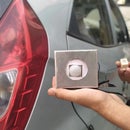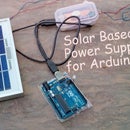Introduction: DIY-GETTING STARTED WITH DRONES (WITH REMOTE CALLIBRATION)
WHat are they and who uses them? Some call them drones, some apply the label “quadcopters” ,though they can have any number of rotors or even be planes— ALSO called them “unmanned aerial systems” (UAS). I prefer to call them “unmanned aerial vehicles” (UAVs).
UAVs are and aren't new. Starting somewhere around 2013, a new trend emerged in the tech toy and aerial imaging market an explosion in popularity of compact multi-rotor RC aircraft, perhaps most notably the DJI Phantom 3 (or similar), a compact quadcopter capable of flying a GoPro either statically mounted or stabilized with a 2-axis gimbal, equipping them with cameras for FPV since cameras got small and video transmitters got cheap. Such technology can have many applications as a hobbiest and as a professional.
Why not to built our own at cheaper rates..:)
So lets get to understanding the drones("quadcopter" in my case) and then i will tell you how to make your own drone including each and every step i used to built my first drone.
>>Lets Get Started
#make_with_kavish
#made_in_India
Step 1: Know Your Quadcopter-How They Work
UVAs break into seven key components:
- Main Controller (MC) or Flight Controller
The heart of the flight-control system, this can be thought of as the “brains” of the UAV. It is an embedded computer that has custom software for controlling the aircraft, sometimes user-reprogrammable. In some designs the MC is a separate module with connection ports. On others, especially consumer products, there may be a single PCB (circuit board) that includes the MC, gyros/sensors, ESCs, and other core flight electronics. You can reffer to photos of MC i used in my drone.
>>I used KK2.1.5 Version of flight control board. They are pretty compact and built in gyros.
- Gyros/Sensors
For autonomy to work, the MC needs to track how the aircraft is flying. To accomplish this, some form of sensor array is provided. Generally, it will include accelerometers, IMUs (inertial measurement units), and gyros, and may also work in conjunction with positional data from an optical flow system or GPS/compass. Basically, these sensors tell the UAV how fast its acceleration is changing, in what direction, and whether it is right-side up. Those familiar with motorized gimbal camera stabilizers may recognize the same sensor technology being employed here as in gimbals.
- Electronic Speed Controllers (ESCs)
Each motor has an ESC . In its most basic form, an ESC regulates power going to the motor with which it is paired. More sophisticated systems can also relay data back to the MC, such as vitals about how the motors are performing. With six or more rotors, active feedback makes it possible to keep flying (enough to land safety) if one motor fails.
- Receiver
This receiver is for the radio control system. It pairs (“binds”) with the controller the pilot or operator holds, which logically, if confusingly, is known as the “transmitter.” Modern receivers typically operate in the 2.4GHz range (like other license-free radio systems such as Wi-Fi) and have four or more channels, extra channels enabling custom functionality to be relayed via the control signal, in addition to basic piloting inputs. In the hobby world, these extra channels might be used for anything from retracting/extending landing gear to firing off a smoke generator. In aerial imaging applications, the extra channels can sometimes be dedicated to gimbal or camera control.
- Motors
In most cases, these are brushless electric motors. The motors are usually paired, each pair a set containing one clockwise (CW) motor partnered with one counterclockwise (CCW) rotating motor, though they may be sold individually. It is important when replacing them or building your own system to use the correct rotational direction in the correct position. This can get confusing, as the propellers are often designated CW or CCW based on which way they screw on, not which way they rotate—which is probably the opposite direction!
- Propellers
Light UAVs use plastic propellers, which resist breaking on impact because they are flexible, and they are safer. Heaver models use carbon fiber or other more rigid materials (planes frequently use wood or nylon/glass). Carbon fiber propellers are dangerous, even deadly, and should be used only by experience pilots and well away from people. Unless extreme performance is a concern, the benefits of carbon fiber over plastic are marginal on multi-rotors.
- Transmitter
This is the radio controller. UAVs equipped with receivers, can work with a range of transmitters. This allows the user to select the best fit, depending on what features they are looking for and what their budget might be. Systems that include a transmitter (as well as other basic accessories required for flying) are dubbed “ready-to-fly,” and are the simplest to jumpstart the beginner. When investing in a transmitter, generally, compatibility can be determined by referring to the specs for the receiver. It will need to support the same protocol as the receiver and support at least as many channels as the receiver requires.
So, for example, 4-channel receiver will work happily with a 6-channel transmitter.
>>I used Fly sky CT6B- 6 channel radio control.
So i think its enough to understand our drone with quite brief introduction and now its time to move to our DIY section..:)
Step 2: Ingredients
- Frame
>>I built my own frame using aluminium bar and acrylic glass plate.
>>You can built the same or buy from market. - Motor x4
>> Motor rating 1000KV - Electronic Speed Control (ESC) x4
>>30A - Flight Control Board
>>KK2.1.5 - Radio transmitter and receiver
>>CT6B 6 Channel - Propeller x4 (2 clockwise and 2 counter-clockwise)
>>10 inches - Battery & Charger
>>11.1v, 3300 mah - Connecting wires x10-15
>>Female to Female Pin Connector Wire
Step 3: Frame Construction
Frame is made by using aluminium bars as shown in figure and for the base I used acrylic glass.
Reffer to figures and photos.Frame should be such that the arm of the drone is compatilbe with the propellers and the mid base for drone should not be over base area ,this will affect the thrust produced by the motor.
Thing to built frame>>
- Aluminium Bars
- Acrylic glass/plate
- Bolts and nuts
- Steel washer
- Rubber washer
Miscellaneous tools>> - Drill machine
- Hot Glue Gun
- Screw driver
The Frame can be made into two configuration that is X-configuration and + configuration.
In this quad copter i used X-configuration.
Step 4: Assembling
Now we have our frame for drone and the next step is to mount all the neccessary part on the frame.
Use screw drivers to tighten the motors on frame as shown in figure.
>>Mount all 4 ESC's on arm of the frame with the help of hot glue and zip ties.
>>Connect the Bullet connectors with the motors
>>Since we have made our own frame,so we need to make our own power distribution system
>> I attach all ESCs below the arm. You can glue them over the frame. This thing does not matter.
Now lets move to make power Distribution for our drone.
Step 5: Power Distribution
All ESCs come with a connector to connect with a battery. But here we can do two things--
- Buy and connect all the connectors with the nesseccary male and female connector ,but this will increase cost as well as increase overall weight
Or - Desolder all the connector and Solder a jumper wire from all ESC in parellel and finally add a single Male connector instead of four as shown in figure, to connect it with a battery.
I used 2nd one. Desolder all the male connector from all the ESCs and connect two single wire for both Positive and Negative wire in parallel and Finally connect a male connector that can connect to a battery.
Figure illustrates more than a theory so lets have a look to all picture..;)
Step 6: Mount Flight Controller and Receiver
Flight controller is connected with the help of female connecting wire as shown.
you can see vedio in order to how to connect Motor and ESCs with flight controller
Flight controll is labelled with the connection and pin to connect like output1,out2,out3,out4,out5,out6,out7,out8.
They connects to our four motor which are female wire on ESCs (red,black,yellow).
Step 7: Binding Transmitter and Receiver
We will receive a binding Cable with a remote inculdes all accessories like Software CD, PC cable, etc.
>>Plug the binding cable into a pin labeled with "bind" on receiver.
>>Supply Power to Receiver using flight controller(connection with FC [fight controller] and receiver will automatically receive power, NO extra connection required)
To bind your transimtter and receiver do the following steps>
- Put battery into remote(DO NOT ON the switch)
- Connect battery on Drone
- Now Press a BIND button(somewhere around bottom left of remote) on remote and switch ON the remote
- The red LED on receiver comes in the stable Mode (before it was blinking)
You are Done with Binding Process..:)
Step 8: Callibrate Your Remote Control Using PC Software.
Install CD into your Computer
Software is so called "T6 Config" and window will appear like photo I attached
Use the following link to change settings
>>callibration vedio.
Use trim button to remove the black area from each channel.
Once you have done all these steps you are ready with youe first move.
Step 9: Initial Setup of Flight Controller
We have to do some changes in Flight controller.
Flight controller comes with LCD screen and 4 buttons to fed some values and configuration.
Here is the Vedio of such settings.
Initial setup KK2.1.5
Go According to these vedios. Dont forget to "Factory Reset" while Getting started initally..:)
After entering all the values and setup into FC. Its time to check out motor rotation and Offcourse first Lifting.
Use remote to ARM your drone in order to fly. This is must for every remote control and flight controll,without this your drone will not move or work. Armed means Action time.;)
Step 10: Fun Time-First Flight
Now you are Ready to Go.
Make sure you are with enough space to fly or else you may need to make another..;)
While Testing you may destroy propllers (same here) but you can change them anytime and get ready again.
Reffer to my videos of first Flight and success Flight.
Video 1:Drone Testing and first flight
video 2:DIY-GETTING STARTED WITH DRONES -SUCCESS FLIGHT
Fell free to contact me if you face any problem while getting started with Drones
.And you are Done.:)
Hope you like my instructable.
Please vote if you like it.
THANKS.





